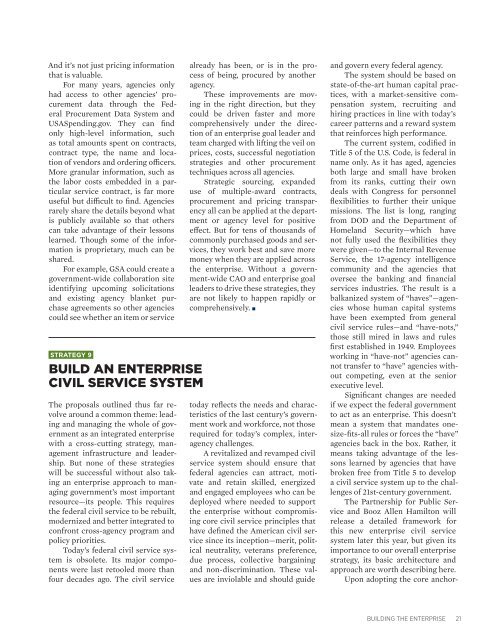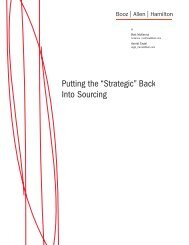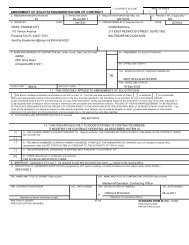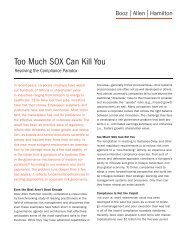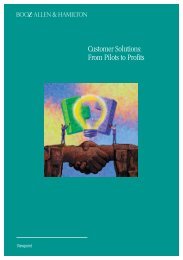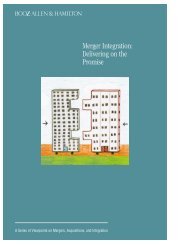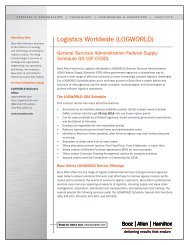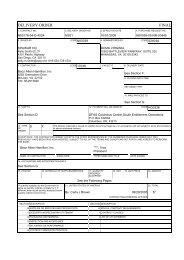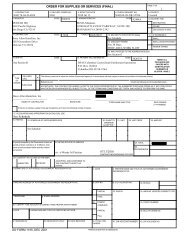Building the Enterprise - Booz Allen Hamilton
Building the Enterprise - Booz Allen Hamilton
Building the Enterprise - Booz Allen Hamilton
- No tags were found...
Create successful ePaper yourself
Turn your PDF publications into a flip-book with our unique Google optimized e-Paper software.
And it’s not just pricing informationthat is valuable.For many years, agencies onlyhad access to o<strong>the</strong>r agencies’ procurementdata through <strong>the</strong> FederalProcurement Data System andUSASpending.gov. They can findonly high-level information, suchas total amounts spent on contracts,contract type, <strong>the</strong> name and locationof vendors and ordering officers.More granular information, such as<strong>the</strong> labor costs embedded in a particularservice contract, is far moreuseful but difficult to find. Agenciesrarely share <strong>the</strong> details beyond whatis publicly available so that o<strong>the</strong>rscan take advantage of <strong>the</strong>ir lessonslearned. Though some of <strong>the</strong> informationis proprietary, much can beshared.For example, GSA could create agovernment-wide collaboration siteidentifying upcoming solicitationsand existing agency blanket purchaseagreements so o<strong>the</strong>r agenciescould see whe<strong>the</strong>r an item or serviceSTRATEGY 9BUILD AN ENTERPRISECIVIL SERVICE SYSTEMThe proposals outlined thus far revolvearound a common <strong>the</strong>me: leadingand managing <strong>the</strong> whole of governmentas an integrated enterprisewith a cross-cutting strategy, managementinfrastructure and leadership.But none of <strong>the</strong>se strategieswill be successful without also takingan enterprise approach to managinggovernment’s most importantresource—its people. This requires<strong>the</strong> federal civil service to be rebuilt,modernized and better integrated toconfront cross-agency program andpolicy priorities.Today’s federal civil service systemis obsolete. Its major componentswere last retooled more thanfour decades ago. The civil servicealready has been, or is in <strong>the</strong> processof being, procured by ano<strong>the</strong>ragency.These improvements are movingin <strong>the</strong> right direction, but <strong>the</strong>ycould be driven faster and morecomprehensively under <strong>the</strong> directionof an enterprise goal leader andteam charged with lifting <strong>the</strong> veil onprices, costs, successful negotiationstrategies and o<strong>the</strong>r procurementtechniques across all agencies.Strategic sourcing, expandeduse of multiple-award contracts,procurement and pricing transparencyall can be applied at <strong>the</strong> departmentor agency level for positiveeffect. But for tens of thousands ofcommonly purchased goods and services,<strong>the</strong>y work best and save moremoney when <strong>the</strong>y are applied across<strong>the</strong> enterprise. Without a government-wideCAO and enterprise goalleaders to drive <strong>the</strong>se strategies, <strong>the</strong>yare not likely to happen rapidly orcomprehensively. •today reflects <strong>the</strong> needs and characteristicsof <strong>the</strong> last century’s governmentwork and workforce, not thoserequired for today’s complex, interagencychallenges.A revitalized and revamped civilservice system should ensure thatfederal agencies can attract, motivateand retain skilled, energizedand engaged employees who can bedeployed where needed to support<strong>the</strong> enterprise without compromisingcore civil service principles thathave defined <strong>the</strong> American civil servicesince its inception—merit, politicalneutrality, veterans preference,due process, collective bargainingand non-discrimination. These valuesare inviolable and should guideand govern every federal agency.The system should be based onstate-of-<strong>the</strong>-art human capital practices,with a market-sensitive compensationsystem, recruiting andhiring practices in line with today’scareer patterns and a reward systemthat reinforces high performance.The current system, codified inTitle 5 of <strong>the</strong> U.S. Code, is federal inname only. As it has aged, agenciesboth large and small have brokenfrom its ranks, cutting <strong>the</strong>ir owndeals with Congress for personnelflexibilities to fur<strong>the</strong>r <strong>the</strong>ir uniquemissions. The list is long, rangingfrom DOD and <strong>the</strong> Department ofHomeland Security—which havenot fully used <strong>the</strong> flexibilities <strong>the</strong>ywere given—to <strong>the</strong> Internal RevenueService, <strong>the</strong> 17-agency intelligencecommunity and <strong>the</strong> agencies thatoversee <strong>the</strong> banking and financialservices industries. The result is abalkanized system of “haves”—agencieswhose human capital systemshave been exempted from generalcivil service rules—and “have-nots,”those still mired in laws and rulesfirst established in 1949. Employeesworking in “have-not” agencies cannottransfer to “have” agencies withoutcompeting, even at <strong>the</strong> seniorexecutive level.Significant changes are neededif we expect <strong>the</strong> federal governmentto act as an enterprise. This doesn’tmean a system that mandates onesize-fits-allrules or forces <strong>the</strong> “have”agencies back in <strong>the</strong> box. Ra<strong>the</strong>r, itmeans taking advantage of <strong>the</strong> lessonslearned by agencies that havebroken free from Title 5 to developa civil service system up to <strong>the</strong> challengesof 21st-century government.The Partnership for Public Serviceand <strong>Booz</strong> <strong>Allen</strong> <strong>Hamilton</strong> willrelease a detailed framework forthis new enterprise civil servicesystem later this year, but given itsimportance to our overall enterprisestrategy, its basic architecture andapproach are worth describing here.Upon adopting <strong>the</strong> core anchor-BUILDING THE ENTERPRISE 21


